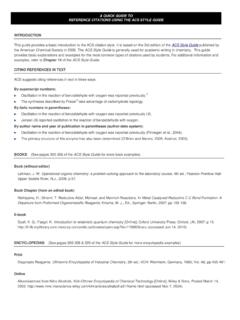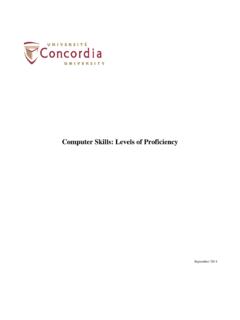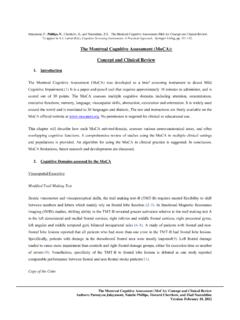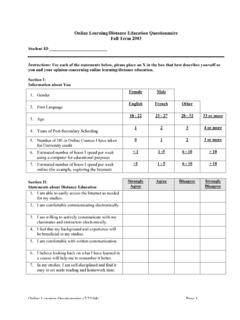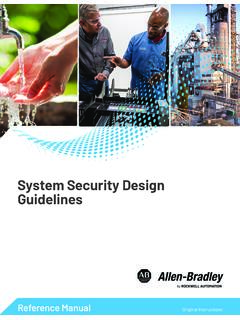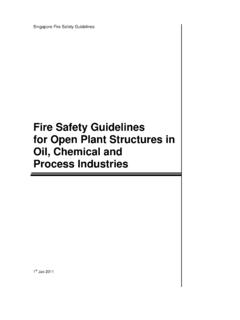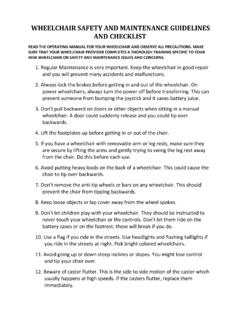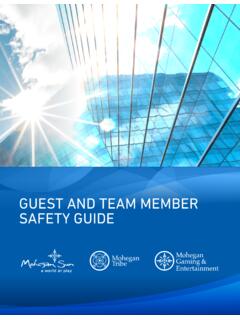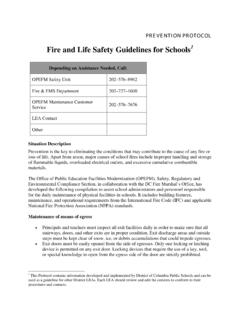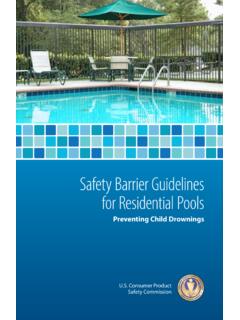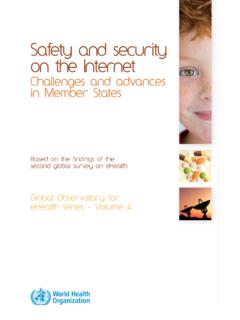Transcription of FORMALDEHYDE SAFETY GUIDELINES - Concordia University
1 EHS-DOC-141 1 / 7 FORMALDEHYDE SAFETY GUIDELINES FORMALDEHYDE is a colorless, strong-smelling gas often found in aqueous solutions called formalin solution, with a maximum concentration of 37-40%. Formalin solutions often contain some amount of methanol (10-15% v/v) as a stabilizer. Fixative solutions labeled as 10% buffered formalin are actually 4% solutions of FORMALDEHYDE (a 10% solution made from a 37-40% solution of FORMALDEHYDE ). Solid (polymerized) forms of FORMALDEHYDE are also available, such as paraformaldehyde (CAS# 30535-89-4) or trioxane (CAS# 123-63-7). FORMALDEHYDE is a common laboratory chemical used as an embalming fluid, tissue preservative, sterilizer, fumigant or starting material for chemical synthesis. Furthermore, FORMALDEHYDE is also found in many products such particle board, household products, glues, permanent press fabrics, paper product coatings, fiberboard and plywood.
2 WARNING : FORMALDEHYDE is a sensitizing agent that can trigger an allergic reaction in normal tissue after single or repeated exposures. It is also classified as a known human carcinogen (cancer-causing substance) by the International Agency for Research on Cancer and as a probable human carcinogen by the Environmental Protection Agency (EPA). Researchers must understand the hazardous properties of FORMALDEHYDE so that control measures can be taken to minimize exposure. 1. Properties Names: FORMALDEHYDE ; Formalin; Methanal; Methylene oxide; Oxymethane; Formic aldehyde; Methyl aldehyde. Chemical Formula: CH2O Chemical Structure: CAS #: 50-00-0 Physical aspect: EHS-DOC-141 2 / 7 Solution ( FORMALDEHYDE 37% w/v): clear, colorless liquid pungent odor soluble in water Table 1. Physical and Toxicological Properties of FORMALDEHYDE Solution (37% w/v) Molar Mass g/mole Boiling point 101 C Melting point 0 C Vapor pressure 40 mm Hg at 39 C Density g/cm3 at 25 C pH N/A PEL (ceiling, Quebec) 2 ppm (3 mg/m3) IDLH (NIOSH) 20 ppm 2.
3 Hazard Classification WHMIS 1988 B3 Combustible liquid D1A Very toxic materials D2A Very toxic materials D2B Toxic materials E Corrosive material WHMIS 2015 Flammable liquids (Category 3) Acute toxicity, Oral (Category 3) Acute toxicity, Inhalation (Category 3) Acute toxicity, Dermal (Category 3) Skin corrosion/irritation (Sub-category 1B) EHS-DOC-141 3 / 7 Serious eye damage/eye irritation (Category 1) Skin sensitisation (Category 1) Germ cell mutagenicity (Category 2) Carcinogenicity (Category 1A) Specific target organ toxicity - single exposure (Category 1) Specific target organ toxicity - (repeated exposure) Category 1 NFPA. Flammability: Flash point below 93 C Health hazard: Extreme danger Instability/Reactivity: Stable 3. Fire and Explosion Hazards A 37% FORMALDEHYDE solution is classified as a Category 3 flammable liquid with a flashpoint of 50 C. Its flammable range is 7 - 70 % (LEL UEL). A 37% FORMALDEHYDE solution becomes a fire or explosion hazard in the presence of heat, flames or other sources of ignition.
4 Upon ignition, the chemical decomposes into carbon oxides ( carbon monoxide, carbon dioxide) which can be hazardous to humans. 4. Health Hazards At normal temperature and atmospheric pressure, FORMALDEHYDE s odor threshold (the lowest concentration detectable) is about - 1 ppm. As the maximum permissible exposure level (ceiling value) is 2 ppm, olfactory detection is not an effective prevention mechanism. When present in air at a concentration near or above ppm, FORMALDEHYDE can cause watery eyes, nausea, coughing, chest tightness, wheezing, skin rashes, allergenic reactions and burning sensations in the eyes, nose and throat. As FORMALDEHYDE is also a sensitizing agent, subsequent exposures can produce symptoms more quickly and at lower concentrations. Long-term exposure can result in headaches, insomnia, depression, mood changes, attention deficit and impairment of dexterity, memory and equilibrium.
5 According to NIOSH, the immediately dangerous to life and health (IDLH) exposure level to FORMALDEHYDE is 20 ppm. This FORMALDEHYDE concentration in air can cause severe injury, including fatal pulmonary edema (water in the lungs). 2 0 3 EHS-DOC-141 4 / 7 FORMALDEHYDE has been shown to cause cancer in laboratory animals and may cause cancer in humans. It also may cause birth defects. It is highly toxic if swallowed, inhaled, or absorbed through skin or mucous membranes. Ingestion of as little as 30 mL (1 oz.) of a solution containing 37% FORMALDEHYDE has been reported to cause death in adults. 5. Stability and Reactivity FORMALDEHYDE is stable under recommended storage conditions. FORMALDEHYDE is incompatible with aniline, phenol, isocyanates, acid anhydrides, strong acids, strong bases, strong oxidizing agents, amines and peroxides. 6. SAFETY Precautions f or FORMALDEHYDE Use Training Students and employees who handle FORMALDEHYDE must have read the SAFETY Data Sheet (SDS) and receive training on the hazards of FORMALDEHYDE concerning: proper handling, use, storage and disposal of FORMALDEHYDE ; substitution to less hazardous chemicals for FORMALDEHYDE ( hydrogen peroxide-based solutions often can be used as disinfectants; ethyl alcohol, polyethylene glycol or phenoxyethanol can be used as fixatives or preservatives); proper use of chemical fume hoods or other applicable local exhaust ventilation, and; spill clean-up and emergency response procedures.
6 The SDS must always be kept the immediate vicinity of the working area along with any Standard Operating Procedure (SOP) developed by the student/employee s department. Engineering Controls The use of local exhaust ventilation ( fume hood) is one of the most efficient control measures for limiting exposure to FORMALDEHYDE . Therefore, FORMALDEHYDE should always be used with adequate ventilation, preferably in a fume hood, to minimize inhalation of vapor FORMALDEHYDE . Biological SAFETY cabinets (BSCs) are not effective engineering controls, as FORMALDEHYDE vapors will go through HEPA filters and will be recirculated within the lab area. FORMALDEHYDE bottles and waste containers should never be left open within the laboratory area. Eye Protection SAFETY glasses, goggles or face shield to minimize the risk of even a small splash or vapor exposure to the corneas. Laboratories and other work areas where FORMALDEHYDE is handled must be equipped with an eyewash station and/or deluge shower in the immediate area capable of providing emergency rinsing and flushing for 15 minutes with fresh water.
7 EHS-DOC-141 5 / 7 Gloves Medium or heavyweight nitrile, neoprene, natural rubber or PVC gloves should be worn when handling concentrated FORMALDEHYDE . Disposable (exam) nitrile gloves may be used when handling dilute concentrations (10% or less). Protection Clothing Long pants, closed toed shoes and a lab coat (or work uniform) should be worn. Other body garments should be used based upon the task being performed ( , sleeve lets, apron, gauntlets, disposable suits). Respiratory Protection Where local exhaust systems are not available and exposure to FORMALDEHYDE vapors is possible, a full face mask that protects both respiratory tracts and eyes must be worn. For FORMALDEHYDE concentrations of: 20 ppm or less: air-purifying respirators such as a full-face respirator with multi-purpose combination (US) or type ABEK (EN 14387) respirator cartridges; 20 ppm or above: full-face supplied air respirator.
8 7. Storage, Spill and Waste Issues Storage As 37% FORMALDEHYDE solution also contains about 15% methanol, containers must be stored in an approved flammable storage cabinet, away from heat and flame. Always place large-volume containers (> 4L) on a low shelf in some kind of secondary containment. Small spill (dilute solution or spill within a fume hood) Spills involving formalin and/or concentrated FORMALDEHYDE solutions are best handled using specially designed urea-based FORMALDEHYDE neutralizers, such as Spill X-FPTM. These neutralizers chemically react with FORMALDEHYDE to form a polymer product that is no longer volatile and much less hazardous. FORMALDEHYDE spill neutralizers are available from different lab suppliers ( Fisher, VWR, etc.). For spills involving small volumes (mL size) of dilute solutions of FORMALDEHYDE ( fixative solution of 4% FORMALDEHYDE ) or spills contained within a fume hood, the following spill cleaning procedure can be used by lab occupants, as long as they are aware of the risks associated with the chemical spilled.
9 They must: wear appropriate personal protective equipment (PPE); remove any ignition source from the spill area; absorb any residual solution with absorbent (spill neutralizer, spill pads, paper ); EHS-DOC-141 6 / 7 clean the spill area with a mixture of water and soap; dry the spill area with paper towels; dispose of any absorbent material along with other chemical waste following Concordia University chemical waste procedures. Lab users should always refer to the chemical s SDS prior to attempt any spill clean-up. If unsure or uncomfortable, lab users should not try to attempt clean up the spill and should contact Security at ext. 3717. Large spill If a large volume of FORMALDEHYDE solution is spilled or if the spill occurs outside a chemical fume hood, lab users should immediately: 1. Advise and warn co-workers; 2. Evacuate the area immediately; 3. Restrict the access to the area; 4. Notify Security at ext.
10 3717 or 514 848-3717, providing them with the following information: a. Location of the spill; b. Name of hazardous material; c. Quantity involved; d. Related health risks and precautions to be taken. 5. Provide SAFETY Data Sheet (MSDS) or appropriate documentation. Waste Handling FORMALDEHYDE solutions should be disposed of as chemical hazardous waste only and not down the drain. Empty FORMALDEHYDE bottles or containers should not be discarded into biohazardous waste containers or broken glass boxes. FORMALDEHYDE bottles or containers with residual amount of liquid can be directly picked-up by EHS. For more information concerning hazardous waste, please contact EHS at 8. Emergency Procedures Skin Contact 1. Immediately rinse the affected area thoroughly with large amounts of water for at least 15 minutes. 2. Remove all contaminated clothing while continuing to flush with water; soap can also be used to wash off chemical.
